Wednesday, April 12, 2006
Recipe File: English Toffee
Toffee is a hard candy made mainly with sugar and butter. In America, the term "English toffee" is generally used for toffee prepared with a coating of chocolate and almonds. This recipe is easy to prepare and yields a full flavored, crunchy toffee that has just a little "stickiness" when chewed.
To create toffee, we will basically heat sugar and butter until the sugar reaches the hard crack stage (300°F / 150°C). If you don't allow the sugar to reach this temperature before cooling, the texture will be different. For example, if heated to the soft crack stage (the temperature range just below hard crack), the candy would be more like a butterscotch than a brittle, crunchy toffee. (In some parts of the world, this is also considered a toffee, but it's not what comes to mind when I hear the word.) If the sugar is heated beyond 320°F (160°C), then it might not retain its solid form and turn into liquid caramel over time.
Assemble the ingredients: 6 oz. (170 g) semi-sweet chocolate chips, 1 cup (200 g) sugar, about 1/2 cup (60 g) chopped almonds, 1 (5 mL) teaspoon vanilla extract, 1/8 teaspoon salt, and 1 cup (225 g) unsalted butter.
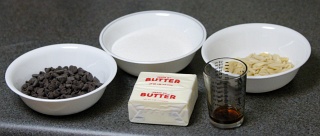
Select a small saucepan. Make sure the saucepan is large enough to contain about double the volume of the butter and sugar. As the mixture cooks, it will bubble and increase in volume - using too small of a pan may result in overflows.
Melt the butter in the saucepan with the sugar and salt plus a little (about 2 teaspoons, 10 mL) water. The extra water will make it easier for the sugar to heat evenly and melt together.
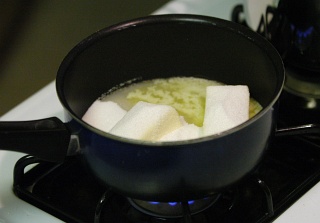
Stir the mixture constantly while heating over medium-high heat. The butter and sugar will bubble and foam as the water boils off. This can take several minutes because butter contains a decent amount of water. The volume of the mixture will increase dramatically at this point. At this point the temperature should be relatively constant at a few degrees above the boiling point of water.
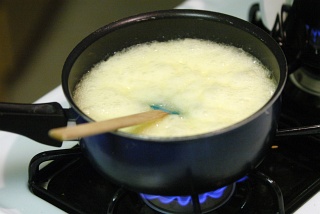
Once the water has boiled off, the mixture will collapse and thicken. The temperature will also start to rise again. The goal is to remove the pan from the heat once the mixture passes 300°F (150°C) and before it reaches 320°F (160°C). Use an instant read thermometer or candy thermometer to keep track of the temperature as you heat and stir because the temperature can change pretty rapidly once the water boils off.
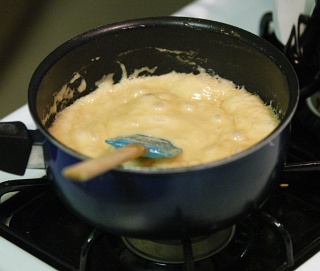
When the mixture reaches 300°F (150°C), remove it from the heat and stir in the vanilla extract. Pour the mixture onto either a silicone baking mat or a large sheet of parchment paper set on top of a sheet pan. The silicone baking mat is probably easiest to work with since it won't slide around on the sheet pan. If you're using parchment paper, one way to keep it in place is to dab the underside of the four corners with a little bit of butter. That will help the paper stay put while the toffee is poured on.
Right after pouring, use a spatula (again silicone works best for working with toffee) to spread the toffee into a rough rectangular shape.
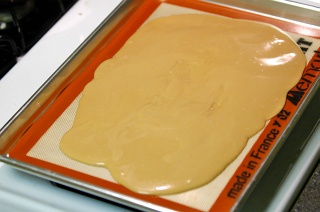
While the toffee is still hot, sprinkle the surface with the chocolate chips. Wait until the bottoms of the chips start to turn shiny and dark brown as they melt from the heat of the toffee, about two minutes. Use your spatula to spread the chocolate. If the chocolate is still mostly solid, wait another minute before attempting to spread again.
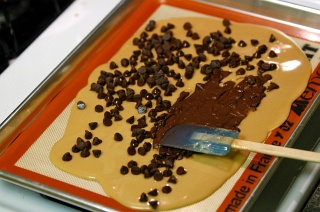
Spread the chocolate so that it covers the toffee.
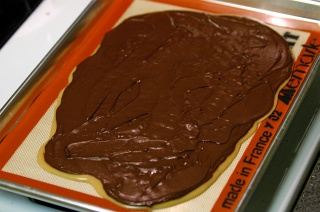
Sprinkle the chocolate surface with chopped almonds. If not using finely chopped almonds, such as the slivered almonds shown in the photos, visually inspect the the surface of the toffee to make sure the almonds are making good contact with the chocolate. Lightly press down on those pieces that are barely touching the surface of the chocolate.
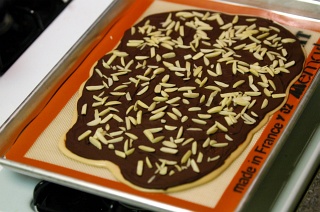
Let the toffee cool for about twenty minutes until the sheet pan returns to room temperature. Slip the pan into the refrigerator to cool down and set for at least thirty minutes.
Remove from the refrigerator and peel the toffee from the baking mat or parchment paper. Working quickly so the chocolate doesn't melt too much, break the toffee into chunks of the desired size and place into an airtight container. During the breaking of the toffee, you'll lose quite a few almond pieces, but don't worry, this is normal.
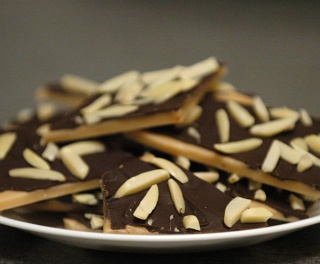
Toffee is a hard candy made mainly with sugar and butter. In America, the term "English toffee" is generally used for toffee prepared with a coating of chocolate and almonds. This recipe is easy to prepare and yields a full flavored, crunchy toffee that has just a little "stickiness" when chewed.
To create toffee, we will basically heat sugar and butter until the sugar reaches the hard crack stage (300°F / 150°C). If you don't allow the sugar to reach this temperature before cooling, the texture will be different. For example, if heated to the soft crack stage (the temperature range just below hard crack), the candy would be more like a butterscotch than a brittle, crunchy toffee. (In some parts of the world, this is also considered a toffee, but it's not what comes to mind when I hear the word.) If the sugar is heated beyond 320°F (160°C), then it might not retain its solid form and turn into liquid caramel over time.
Assemble the ingredients: 6 oz. (170 g) semi-sweet chocolate chips, 1 cup (200 g) sugar, about 1/2 cup (60 g) chopped almonds, 1 (5 mL) teaspoon vanilla extract, 1/8 teaspoon salt, and 1 cup (225 g) unsalted butter.

Select a small saucepan. Make sure the saucepan is large enough to contain about double the volume of the butter and sugar. As the mixture cooks, it will bubble and increase in volume - using too small of a pan may result in overflows.
Melt the butter in the saucepan with the sugar and salt plus a little (about 2 teaspoons, 10 mL) water. The extra water will make it easier for the sugar to heat evenly and melt together.

Stir the mixture constantly while heating over medium-high heat. The butter and sugar will bubble and foam as the water boils off. This can take several minutes because butter contains a decent amount of water. The volume of the mixture will increase dramatically at this point. At this point the temperature should be relatively constant at a few degrees above the boiling point of water.

Once the water has boiled off, the mixture will collapse and thicken. The temperature will also start to rise again. The goal is to remove the pan from the heat once the mixture passes 300°F (150°C) and before it reaches 320°F (160°C). Use an instant read thermometer or candy thermometer to keep track of the temperature as you heat and stir because the temperature can change pretty rapidly once the water boils off.

When the mixture reaches 300°F (150°C), remove it from the heat and stir in the vanilla extract. Pour the mixture onto either a silicone baking mat or a large sheet of parchment paper set on top of a sheet pan. The silicone baking mat is probably easiest to work with since it won't slide around on the sheet pan. If you're using parchment paper, one way to keep it in place is to dab the underside of the four corners with a little bit of butter. That will help the paper stay put while the toffee is poured on.
Right after pouring, use a spatula (again silicone works best for working with toffee) to spread the toffee into a rough rectangular shape.

While the toffee is still hot, sprinkle the surface with the chocolate chips. Wait until the bottoms of the chips start to turn shiny and dark brown as they melt from the heat of the toffee, about two minutes. Use your spatula to spread the chocolate. If the chocolate is still mostly solid, wait another minute before attempting to spread again.

Spread the chocolate so that it covers the toffee.

Sprinkle the chocolate surface with chopped almonds. If not using finely chopped almonds, such as the slivered almonds shown in the photos, visually inspect the the surface of the toffee to make sure the almonds are making good contact with the chocolate. Lightly press down on those pieces that are barely touching the surface of the chocolate.

Let the toffee cool for about twenty minutes until the sheet pan returns to room temperature. Slip the pan into the refrigerator to cool down and set for at least thirty minutes.
Remove from the refrigerator and peel the toffee from the baking mat or parchment paper. Working quickly so the chocolate doesn't melt too much, break the toffee into chunks of the desired size and place into an airtight container. During the breaking of the toffee, you'll lose quite a few almond pieces, but don't worry, this is normal.
